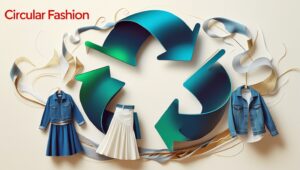Circular fashion aims to keep materials and products in use for as long as possible. It recognizes that clothes, fabric, and fibers have value beyond their initial use and seeks to close the loop by designing out waste and pollution.
At the core of circular fashion lies the idea that materials can be reused, repaired, recycled, or repurposed. This means clothes are built to last, easy to fix, and designed with end-of-life considerations in mind. The goal is to create a system where garments move through cycles of reuse and regeneration rather than being tossed in the trash.
The fashion industry consumes vast amounts of water, energy, and chemicals, and the environmental footprint grows larger every year. Adopting circular principles helps reduce this impact by extending the life of textiles and reducing the demand for new raw materials.
Designing for Circularity
Pieces are created with fast fashion trends in mind, emphasizing low cost and rapid turnover instead of durability or longevity. Circular fashion puts design at the center of sustainability.
Designers focusing on circularity carefully select materials that can be recycled or biodegradable. Natural fibers like organic cotton, hemp, or wool tend to break down more easily than synthetic fibers like polyester. Designers also use modular designs or clever construction techniques that make it easy to take garments apart or repair them.
Creating clothes that people want to wear for years means they won’t be discarded as quickly. Classic cuts, neutral colors, and versatile clothes contribute to this, encouraging consumers to invest in pieces that provide long-term value.
Labels and brands that embrace circular fashion often provide care instructions and repair services to help consumers maintain their clothing properly. They may also design garments that can be transformed – for instance, jackets that can be disassembled into smaller pieces or clothes with interchangeable parts.
Innovative Technologies Driving Circular Fashion
Mechanical recycling involves shredding old textiles and re-spinning fibers, though fiber quality drops over time. Chemical recycling breaks fibers down to their raw components, allowing new fabrics to be spun with a virgin-like quality. Brands and innovators are now partnering with recycling facilities to pull garments back into the production cycle.
Digital technologies, such as blockchain and RFID tags, are helping brands track materials through the supply chain. This transparency allows companies to know exactly where their fabrics come from and where they’re going, enabling better end-of-life management and encouraging reuse.
There have been innovations in bio-fabrication, where companies create fabrics using fermented microbes or plant-based materials. These fabrics tend to be biodegradable and less harmful to the environment, supporting circular systems where materials return safely to nature after use.
3D knitting and zero-waste pattern cutting are additional innovations that reduce textile waste during production. By knitting entire garments in one piece or cutting patterns to minimize scraps, manufacturers create less leftover fabric that would otherwise go to waste.
 The Role of Consumers in Circular Fashion
The Role of Consumers in Circular Fashion
Thinking carefully about whether you need a garment or if it fits your style and lifestyle reduces impulse buys that end up unworn. Choosing higher-quality items that last longer may cost more upfront, but saves money and waste in the long run.
Washing clothes less frequently, using gentle detergents, and repairing small damages extend garment life significantly. Simple fixes like sewing torn seams or replacing buttons keep items wearable and out of the trash.
When clothes no longer fit or aren’t wanted, responsible disposal is vital. Donating, selling, or swapping items keeps garments in circulation and gives them a second life. Some brands offer take-back programs so pieces can be recycled or remade into new products.
Consumers can also embrace rental and secondhand shopping to reduce demand for new items. Renting clothes for special occasions or buying used pieces avoids creating new waste while still meeting fashion needs.
How Brands Are Making a Difference
Some brands use recycled fibers to create new collections. Turning plastic bottles into polyester yarn or recycling old garments into fresh fabric helps close the materials loop.
Others offer repair services or warranties that encourage customers to keep items longer. Brands that provide customization and modular clothes help people update or change their fashion without buying entirely new garments.
A growing number of labels are shifting towards made-to-order or limited production to avoid overstock and deadstock waste.
Collaborations between brands, recyclers, and technology startups are accelerating innovation. By sharing knowledge and resources, they develop better systems to recycle textiles or introduce new sustainable fabrics.
Initiatives like clothing rental platforms and resale marketplaces are gaining popularity as brands explore circular business models that rely less on volume sales and more on reuse.
What Can You Do to Support Circular Fashion?
Start by buying fewer, better-quality pieces that you truly love. Focus on durability and timelessness rather than fast trends. Care for your clothes properly—wash in cold water, air dry when possible, and avoid harsh chemicals.
If an item rips or tears, try mending it yourself or seeking out local repair shops. Before tossing clothes, consider donating, selling them online, or swapping with friends.
Explore secondhand stores and rental services when you want something fresh without creating new waste. When purchasing new items, check if the brand uses recycled or eco-friendly materials and if they have take-back programs.
Spread the word about circular fashion. The more people know about these ideas, the stronger the shift toward a waste-free, sustainable fashion future becomes.
By designing smarter, using resources thoughtfully, and involving everyone from makers to users, the fashion world can transform itself into a more responsible and creative space. Every choice counts, and together, we can make fashion circular, sustainable, and truly innovative.



